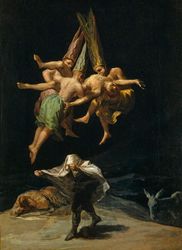Popular themes in art indicate the direction in which a Covid-fatigued world is headed. It’s not that art imitates life or life imitates art. It is just that artists have a different perspective and sensibility from journalists, politicians, and decision-makers swirling in the throes of fast-paced developments. The message from the art world is that 2022 will be a year of warriors and women, of faces, fantasy, and feelings. It is both new, and to renew.
Last year, we lived in bubbles. But European art throbbed with fantasy and realism, remembering and portraying life as we knew or imagined it. Exhibitions were big on fantasy, not surprising because people easily slip into the make-believe amid pandemic-induced loneliness. In Basel, the exhibition on Spanish artist Francisco Goya (1746–1828) was a powerful magnet. Goya’s saints and sinners, ghouls and witches inhabit realms where reality and fantasy merge. His genius lay in depicting the drama that unspools when reason meanders into irrationality.
Alice in Wonderland incarnated in London’s Victoria and Albert Museum with vanishing rabbits and psychedelic tea parties. Overwhelmed by the changes around her, Alice wonders “Who in the world am I?”
Figurative painting ruled the year. Freudian analysis suggests audiences craved to connect with faces: different, diverse, dramatic, or drab. It didn’t matter, so long as they were human. People thronged to see the tableaux of portraits, absorbing the expressions depicted in exquisite detail—the supercilious duchess, the smirking lieutenant, the crafty merchant.
The health of the planet nagged people’s consciousness. The Nobel prize of painting, the Praemium Imperiale, was awarded to rainforest photographer Sebastião Salgado for his stunning monochromatic images in silken black, blinding white and shadowy grey to powerfully convey human misery amid a ravaged environment.
Exhibition trends suggest that the art world—and society—has entered not kalyug, but shakti yug. In Tate Gallery, eight of the nine solo presentations of living artists were by women. Another presented the works of women artists who succeeded in invading the male-dominated domain of 19th century art. A Swiss exhibition presents female artists who capture the feminine experience through nude portraits of women with pregnant bellies and sagging breasts. Through their unflinching portraits, these women artists subvert the stereotypical male depiction of the female form as seductive, voluptuous, mysterious, or long-suffering.
In addition to gender battles, cultural and political wars invaded the hallowed precincts of museums like never before. Slavery, racism, and the construction of identity in exile were illustrated with rage and rancour. Critics trumpeted the arrival of a new star on the art firmament, painter Michael Armitage, 37. They raved about his “sumptuous surfaces, luminous colour and exhilarating brushstrokes”. Beneath the visual feast, are dark portraits about current and post-colonial conflicts that challenge historical assumptions.
In between lockdowns, several magnificent, quaint, and controversial museums opened or reopened across Europe to showcase human genius. The 13-storeyed Munch Museum dedicated to Norwegian artist Edvard Munch, considered the father of modern art, opened in the spectacular surroundings of the Oslofjord. Paris came up with the renewed Musée Carnavalet, clever and quirky with old shop signs and miniature guillotines in ivory.
In summer, the refurbished Casa Balla opened in Rome, colourful and futurist, crystallising the human experience from endurance to exuberance. Italian artist Giacomo Balla lived and worked here through fascism and war, a reminder that calamities recede into history, but life and art endure. Pandemics, mass extinctions, wars, and other doomsday scenarios notwithstanding, our world with all its whims and beauty, paradox and flaws, keeps spinning.
Pratap is an author and journalist.


